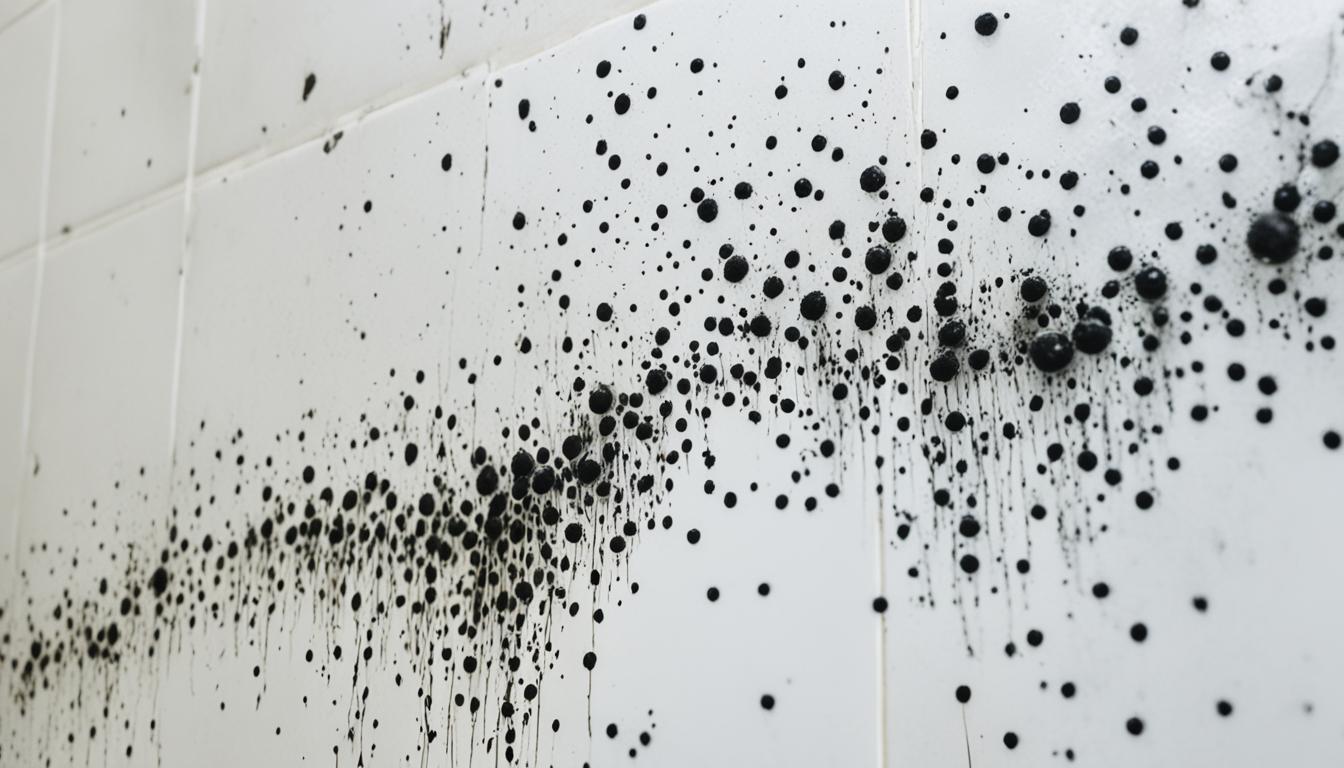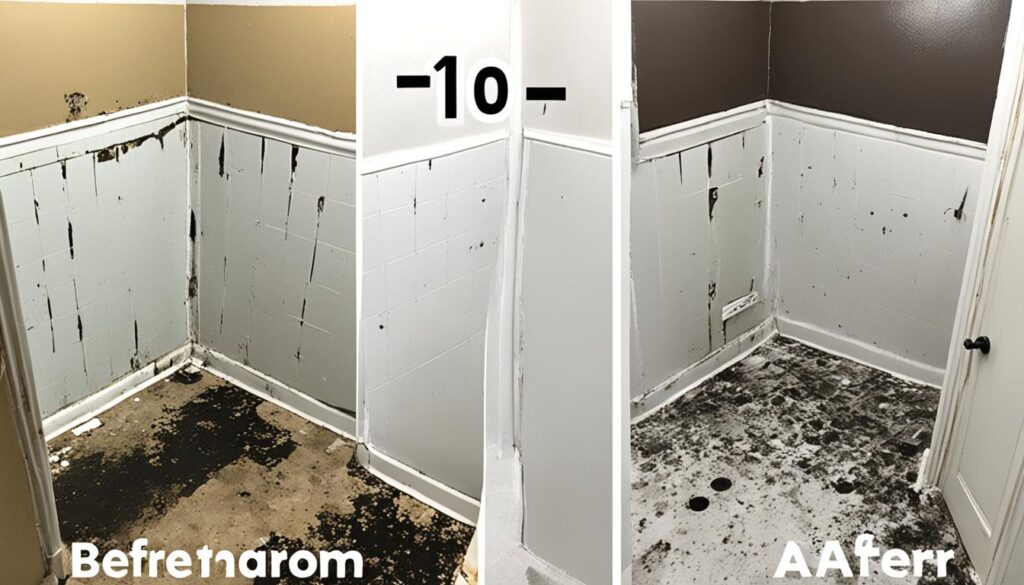
Innovative Techniques for black Mold in bathroom
Welcome to our comprehensive guide on combating black mold in bathroom spaces. In this article, we will explore innovative techniques and strategies to effectively clean up and prevent black mold, ensuring your bathroom remains pristine and healthy. Black mold can pose serious health risks and structural issues, so it’s crucial to address this problem promptly and efficiently.
Key Takeaways:
- Black mold in the bathroom can be a health hazard and lead to structural damage.
- Understanding the dangers associated with black mold is essential for effective remediation and prevention.
- Implementing groundbreaking clean-up techniques and prevention strategies is crucial for long-term success.
- Regular maintenance and proper ventilation can help prevent black mold growth in the bathroom.
- Seek professional assistance if the black mold problem persists or becomes severe.
Now, let’s delve into the dangers of black mold in the next section and understand why it requires immediate attention.
Understanding the Dangers of Black Mold
Before diving into the techniques to tackle black mold, it is crucial to understand the potential dangers it poses. Black mold, also known as Stachybotrys chartarum, is a type of toxic mold that can grow in damp and humid environments, including bathrooms. Its presence can have severe health implications and may even compromise the structural integrity of your home.
Exposure to black mold can lead to a range of health issues, especially for individuals with respiratory conditions, allergies, or weakened immune systems. The spores released by black mold can cause allergic reactions, such as nasal congestion, coughing, and skin irritation. Prolonged exposure or inhalation of these spores can also result in more severe symptoms, including breathing difficulties, persistent headaches, and fatigue.
Furthermore, black mold can have detrimental effects on the structure of your bathroom. It thrives on moist surfaces, such as tile grout, caulk, and wallpaper. Over time, it can cause discoloration, deterioration, and even structural damage. Ignoring the presence of black mold can lead to costly repairs and compromise the safety of your home.
“The dangers of black mold in your bathroom should not be underestimated. It poses significant health risks and can compromise the integrity of your home’s structure. It’s crucial to take immediate action.”
To help you visualize the impact of black mold, here’s a table summarizing the health risks and structural implications:
| Health Risks | Structural Implications |
|---|---|
| Respiratory issues | Discoloration of surfaces |
| Allergic reactions | Deterioration of grout and caulk |
| Headaches and fatigue | Compromise of wallpaper |
| Breathing difficulties | Structural damage |

Groundbreaking Clean-up and Prevention Strategies
When it comes to black mold in the bathroom, effective clean-up and prevention strategies are crucial to maintain a healthy and mold-free environment. In this section, we will explore innovative techniques that specifically target black mold removal and prevention, ensuring your bathroom remains pristine.
The Importance of Clean-up and Prevention
Black mold not only poses health risks but can also cause structural damage if left unaddressed. It thrives in damp and humid environments, making bathrooms susceptible to mold growth. Taking proactive measures to clean up existing mold and prevent its reoccurrence is essential to safeguard your well-being and maintain the integrity of your bathroom.
Cleansing Agents and Tools
When it comes to clean-up, selecting the right cleansing agents and tools is crucial for effective mold removal. Here are some recommended options:
- Bleach: A powerful disinfectant that can target mold spores and eliminate them. Dilute bleach in water according to the manufacturer’s instructions and apply it to the affected areas.
- Vinegar: Known for its natural cleaning properties, vinegar is a safe and effective option to remove mold. Mix equal parts vinegar and water and apply the solution to the mold-infested areas.
- Baking Soda: A versatile household ingredient, baking soda can help eliminate mold and absorb moisture. Create a paste by mixing baking soda with water and apply it to the affected areas. Scrub gently with a brush and rinse thoroughly.
In addition to cleansing agents, utilizing the right tools can enhance the effectiveness of your clean-up efforts. Consider using:
- Scrub brushes: Choose brushes with firm bristles to help remove mold from surfaces.
- High-efficiency particulate air (HEPA) filters: HEPA vacuum cleaners and air purifiers can capture mold spores and prevent their circulation.
- Protective gear: Wear gloves, goggles, and masks to protect yourself from mold exposure during the cleaning process.
Prevention Techniques
Preventing black mold growth in the bathroom requires addressing underlying causes of moisture. Consider implementing the following prevention strategies:
- Proper ventilation: Install exhaust fans or open windows to improve air circulation and reduce humidity levels in the bathroom.
- Maintain dry surfaces: Wipe down wet surfaces, such as shower walls and countertops, after use to prevent moisture buildup.
- Fix leaks: Promptly repair any plumbing leaks or water damage to prevent mold growth behind walls or under fixtures.
- Regular cleaning: Clean your bathroom regularly to remove any potential mold spores and prevent their growth. Focus on areas prone to moisture, such as shower curtains, grout, and tiles.
- Use mold-resistant materials: Consider using mold-resistant paint, tiles, and sealants in your bathroom to create a moisture-resistant environment.
| Cleansing Agents | Effectiveness | Preparation |
|---|---|---|
| Bleach | High | Dilute bleach in water |
| Vinegar | Moderate | Mix equal parts vinegar and water |
| Baking Soda | Moderate | Create a paste with baking soda and water |

Conclusion
In conclusion, combating black mold in the bathroom requires a proactive approach that focuses on thorough clean-up and prevention. By implementing the innovative techniques and strategies discussed in this article, you can ensure that your bathroom remains a pristine and healthy sanctuary.
Remember, the first step is to understand the dangers of black mold and its potential health risks and structural implications. Armed with this knowledge, you can then proceed to tackle the issue head-on with groundbreaking clean-up and prevention strategies.
Utilize effective cleansing agents, tools, and techniques specifically tailored to black mold in the bathroom. Regularly inspect your bathroom for any signs of mold growth, and promptly address any areas of concern. By taking a proactive and consistent approach to combatting black mold, you can create a safe and mold-free environment in your bathroom.




